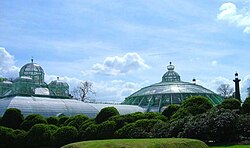| Royal Greenhouses of Laeken | |
|---|---|
 The Congo Greenhouse (left) and the Winter Garden (right), part of the Royal Greenhouses of Laeken | |
 Interactive map of Royal Greenhouses of Laeken | |
| Type | Greenhouses |
| Location | Laeken, City of Brussels, Brussels-Capital Region, Belgium |
| Coordinates | 50°53′18″N4°21′37″E / 50.88833°N 4.36028°E |
| Area | 2.5 ha (6.2 acres) |
| Created | 1874 |
| Owned by | Belgian State (donation of the Royal Heritage) |
| Public transit access | |
| Website | www |
The Royal Greenhouses of Laeken (French : Serres royales de Laeken, Dutch : Koninklijke Serres van Laken) are a vast complex of monumental heated greenhouses in the park of the Royal Palace of Laeken (northern part of the City of Brussels), Belgium. The historic complex contains tropical, subtropical and cold greenhouses, [1] and is home to the famous Royal Botanic Collection, which includes large collections of camellias, orange trees and many plants originating from the African parts of the former Belgian Empire.
Contents
- History
- Inception and construction
- Present-day
- Description
- Orangery
- Winter Garden
- Other greenhouses
- Royal Botanic Collection
- Visit
- Gallery
- See also
- References
- Citations
- Bibliography
- External links
The greenhouses were commissioned by King Leopold II, originally designed by the architect Alphonse Balat, and built between 1874 and 1905. [2] Following Balat's death in 1895, Leopold called upon the architects Henri Maquet and Charles Girault. They are now part of the Royal Domain of Laeken and the royal private gardens belonging to the Belgian royal family, and are accessible to the public only a few days a year. This site is served by Stuyvenbergh metro station on line 6 of the Brussels Metro.



















